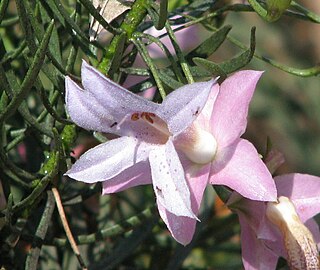
Eremophila abietina, also known as spotted poverty bush, is a plant in the figwort family, Scrophulariaceae and is endemic to a few arid areas of Western Australia. It is a stiff, upright, compact and very sticky shrub with distinctive, dark bluish-green leaves and pale coloured flowers spotted purple.
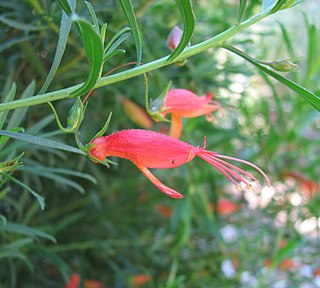
Eremophila decipiens, commonly known as slender fuchsia bush or narrow-leaved fuchsia bush is a flowering plant in the figwort family, Scrophulariaceae and is endemic to an area extending from the south-west of Western Australia to southern parts of South Australia. It is low, sprawling shrub with lance-shaped leaves and red, orange or yellow flowers on a long, S-shaped stalk.
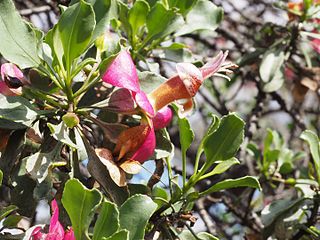
Eremophila fraseri, commonly known as burra or jilarnu, is a flowering plant in the figwort family, Scrophulariaceae and is endemic to Western Australia. It is a shrub or small tree with all above-ground parts of the plant, apart from the petals, sticky and shiny due to the presence of a large amount of resin. The petals are coloured white, cream, pink and brown.

Eremophila brevifolia, also known as spotted eremophila, is a flowering plant in the figwort family, Scrophulariaceae and is endemic to the south-west of Western Australia. It is an erect, open, spindly shrub with sticky, short, serrated leaves and white to pink flowers and is only known from a few scattered populations.

Eremophila scaberula, commonly known as rough emu bush, is a flowering plant in the figwort family Scrophulariaceae, and is endemic to Western Australia. It is a low growing, heath-like shrub with crowded leaves and which produces solitary pale to dark purple flowers in the leaf axils predominantly between July and October in its native range.

Fumaria muralis, known as common ramping-fumitory or wall fumitory, is a flowering herbaceous plant in the poppy family (Papaveraceae) native to western Europe and northwestern Africa.

Hibbertia obtusifolia, commonly known as hoary guinea flower, is a species of flowering plant in the family Dilleniaceae and is endemic to south-eastern Australia. It is usually an erect shrub with spreading branches, lance-shaped to egg-shaped leaves with the narrower end towards the base, and yellow flowers with thirty or more stamens arranged around three glabrous carpels.

Hibbertia pedunculata, commonly known as stalked guinea-flower, is a species of flowering plant in the family Dilleniaceae and is endemic to New South Wales. It is a diffuse, prostrate or erect shrub with linear leaves and yellow flowers borne on a relatively long peduncle, the flowers with fifteen to twenty stamens arranged around two hairy carpels.

Beyeria viscosa, commonly known as the pinkwood or sticky wallaby bush, is a species of flowering plant in the spurge family, Euphorbiaceae, that is endemic to Australia.
Eremophila compacta, commonly known as compact poverty bush, is a flowering plant in the figwort family, Scrophulariaceae and is endemic to the central west of Western Australia. There are two distinct subspecies differing in their growth habit but both have grey leaves due to a covering of white or grey hairs, and purple to blue, rarely white flowers.
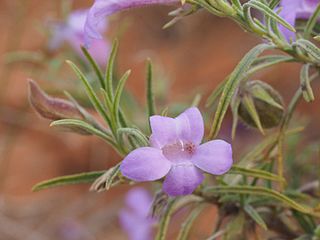
Eremophila gilesii, commonly known Charleville turkey bush, green turkey bush, desert fuchsia and Giles emu bush is a flowering plant in the figwort family, Scrophulariaceae and is endemic to Australia. It is usually a low, spreading shrub with pinkish-lilac to purple flowers and is widespread in the Northern Territory and all mainland states except Victoria. It is considered a difficult agricultural weed in some parts of Queensland but is often used as a bush medicine by Aboriginal people.

Eremophila glutinosa, commonly known as sticky emu bush, is a flowering plant in the figwort family, Scrophulariaceae and is endemic to Western Australia. It is an erect, densely foliaged shrub with branches and leaves sticky and shiny due to the presence of resin. It has hairy sepals and lilac-coloured flowers.

Eremophila serrulata, commonly known as serrate-leaved eremophila, is a flowering plant in the figwort family, Scrophulariaceae and is endemic to Australia. It is an erect or spreading shrub whose leaves are sticky and have small serrations, and flowers that have green, yellowish-green or yellowish-brown petals.

Bertya opponens is a shrub/tree in the family Euphorbiaceae, native to Australia and found in New South Wales and Queensland. It is found on ridges amongst mallee in shallow soils. It flowers in July and August.

Hibbertia virgata, commonly known as twiggy guinea flower, is a species of flowering plant in the family Dilleniaceae and is endemic to south-eastern Australia. It is an erect shrub with linear leaves and yellow flowers with ten to twelve stamens arranged around three glabrous carpels.
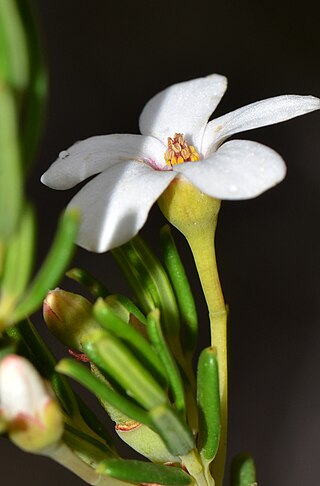
Ricinocarpos cyanescens is a species of flowering plant in the family Euphorbiaceae and is endemic to the south-west of Western Australia. It is a compact, monoecious shrub with narrowly oblong leaves and male and female flowers arranged singly or in small groups.
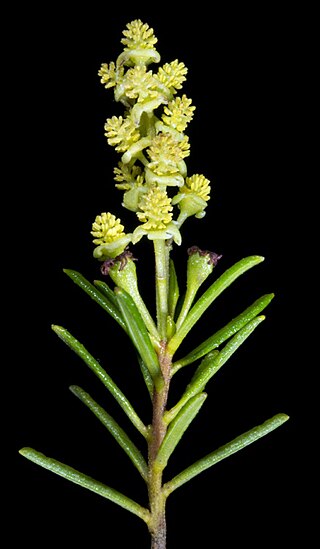
Ricinocarpos muricatus is a species of flowering plant in the family Euphorbiaceae and is endemic to the south-west of Western Australia. It is an erect to spreading, sticky, monoecious shrub with linear leaves and yellow flowers arranged in a raceme, with one or two female flowers surrounded by 8 to 12 male flowers.
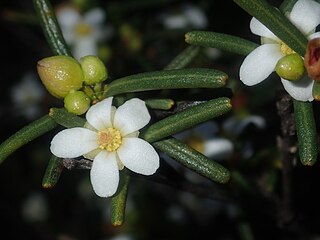
Ricinocarpos psilocladus is a species of flowering plant in the family Euphorbiaceae and is endemic to the west coast of Western Australia. It is an erect, open, monoecious or dioecious shrub with linear to narrowly oblong or narrowly egg-shaped leaves, and white or yellow flowers arranged singly, or with two to five male flowers, or a single female flower surrounded by up to three male flowers.
Ricinocarpos stylosus is a species of flowering plant in the family Euphorbiaceae and is endemic to the Norseman district of Western Australia. It is a spreading, rounded, monoecious or dioeceous shrub or small tree, with linear to narrowly oblong leaves and female flowers arranged singly, or with two to five male flowers, or a single female flower surrounded by up to four male flowers.

Ricinocarpos tuberculatus is a species of flowering plant in the family Euphorbiaceae and is endemic to the south-west of Western Australia. It is an erect, monoecious or dioecious shrub or small tree with linear leaves, and white flowers in a umbel with either 2 to 7 male flowers or a single female flower surrounded by up to 5 male flowers.



















